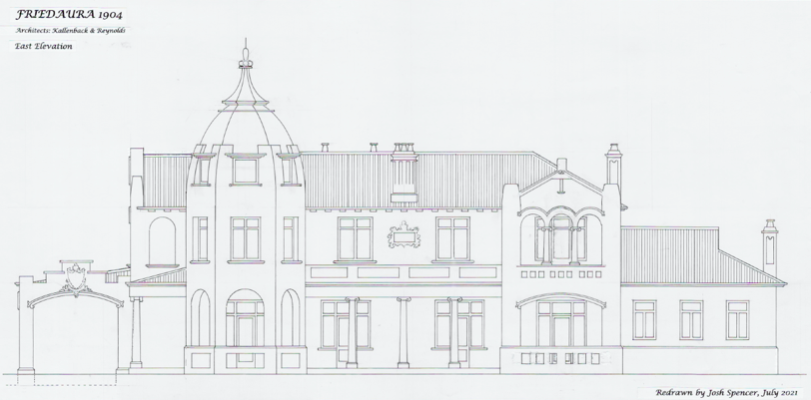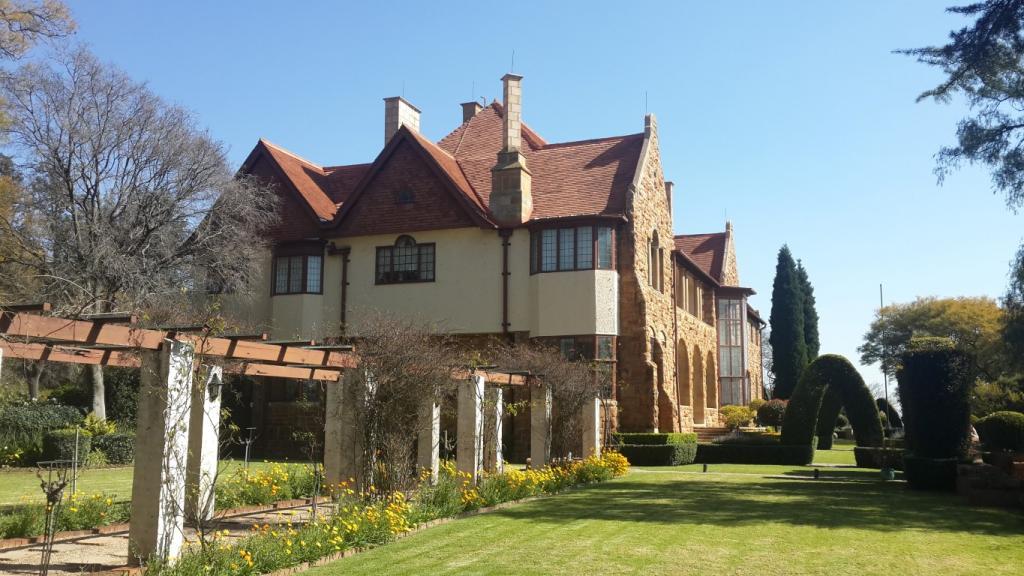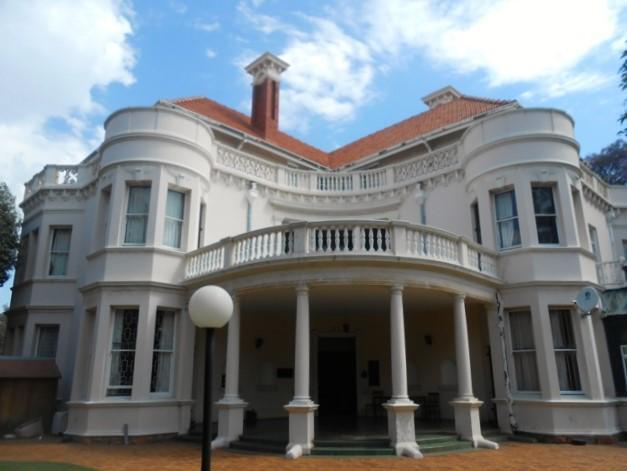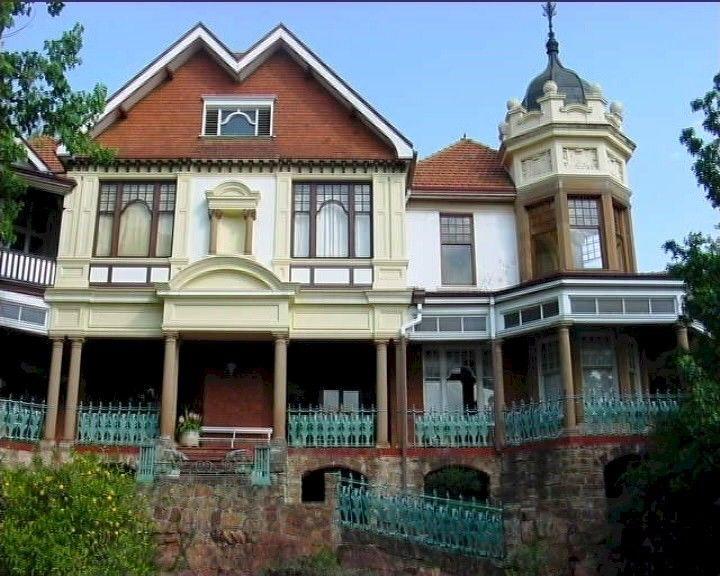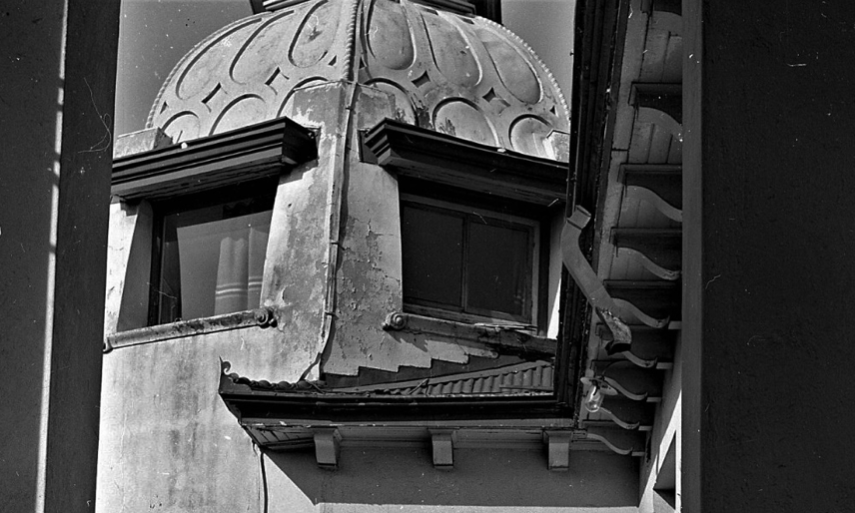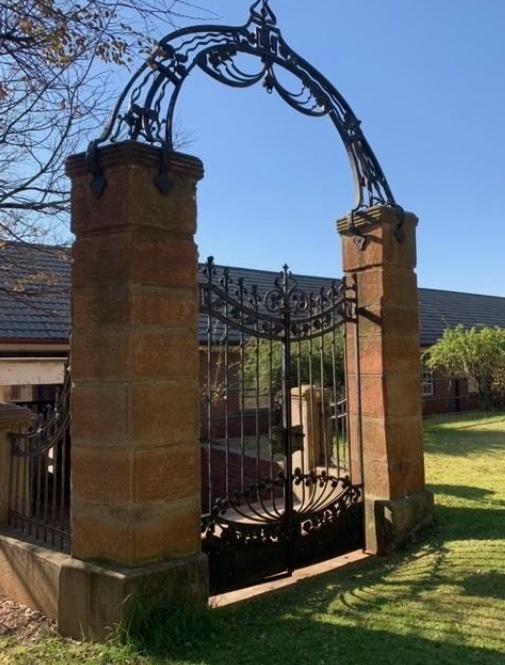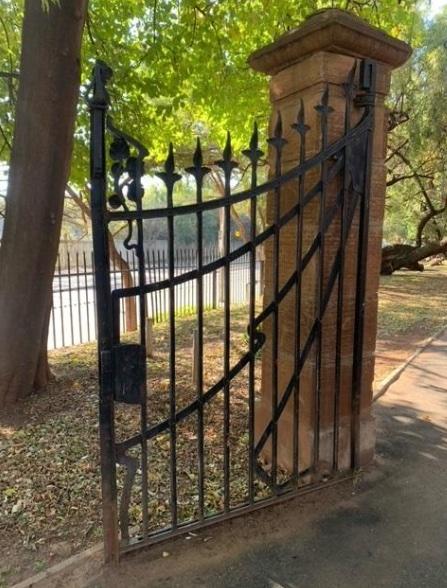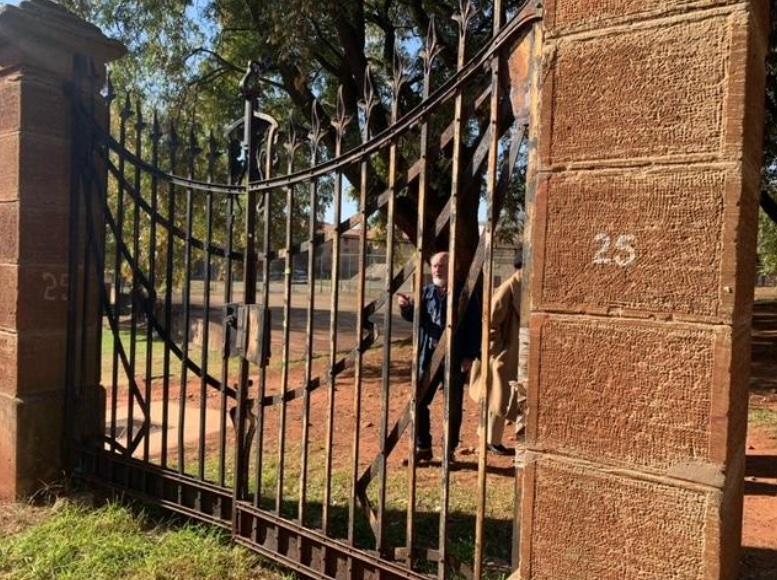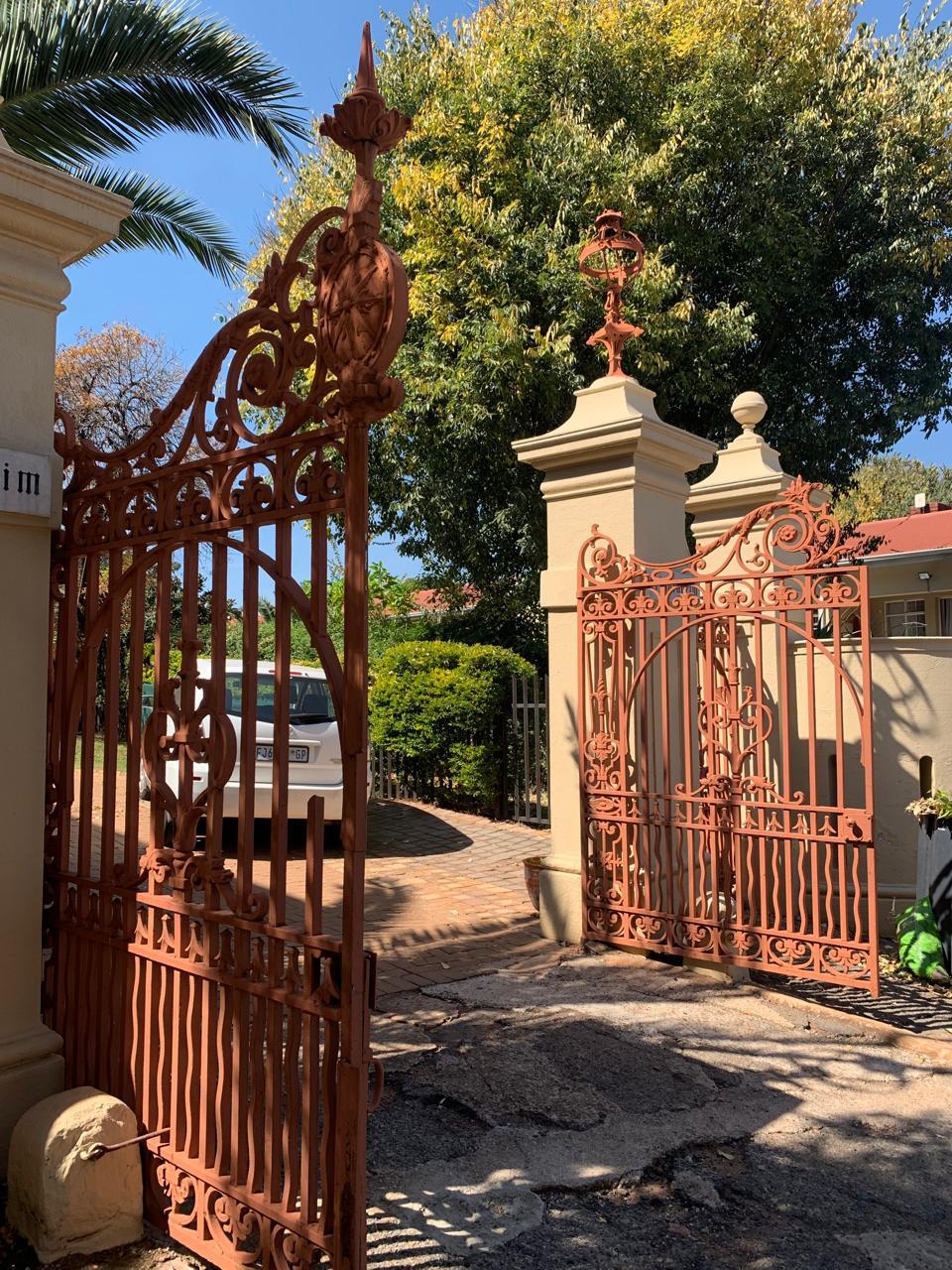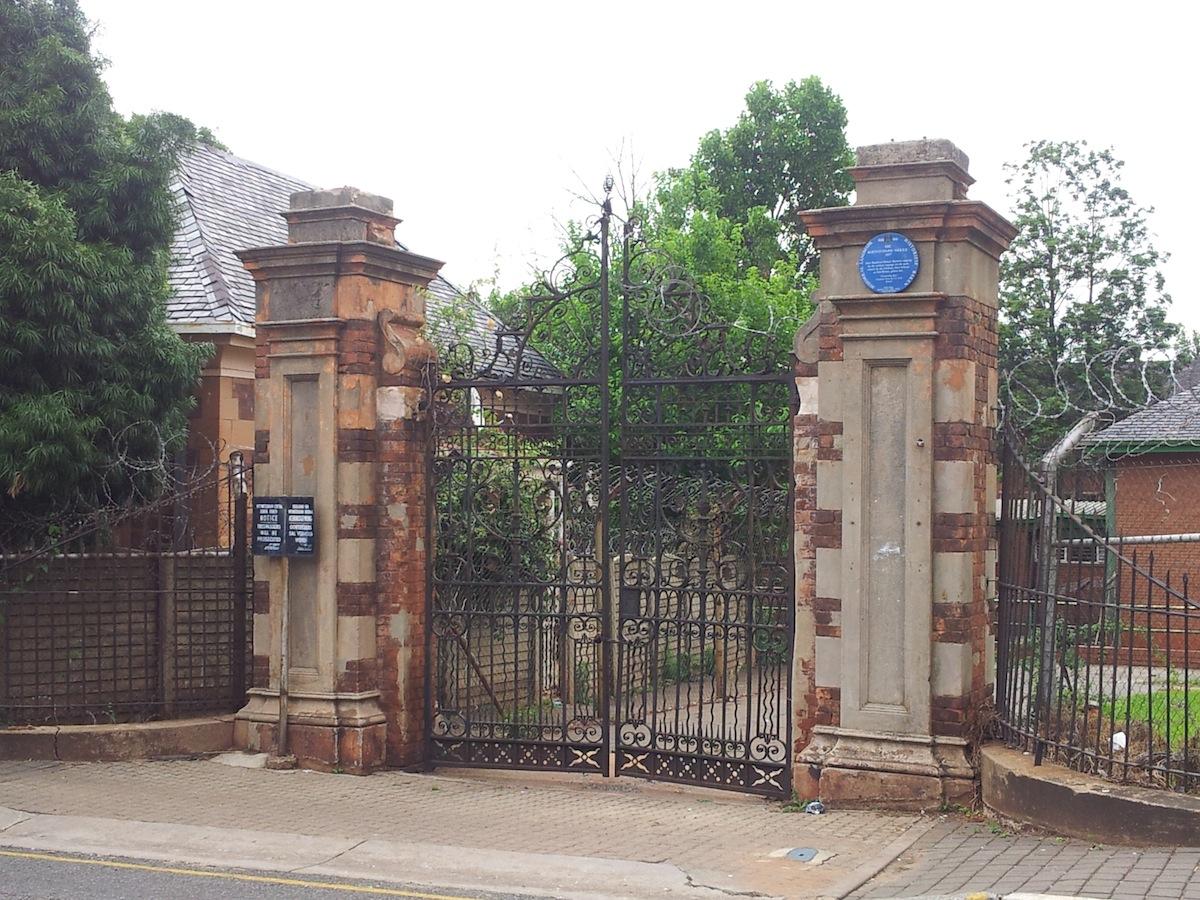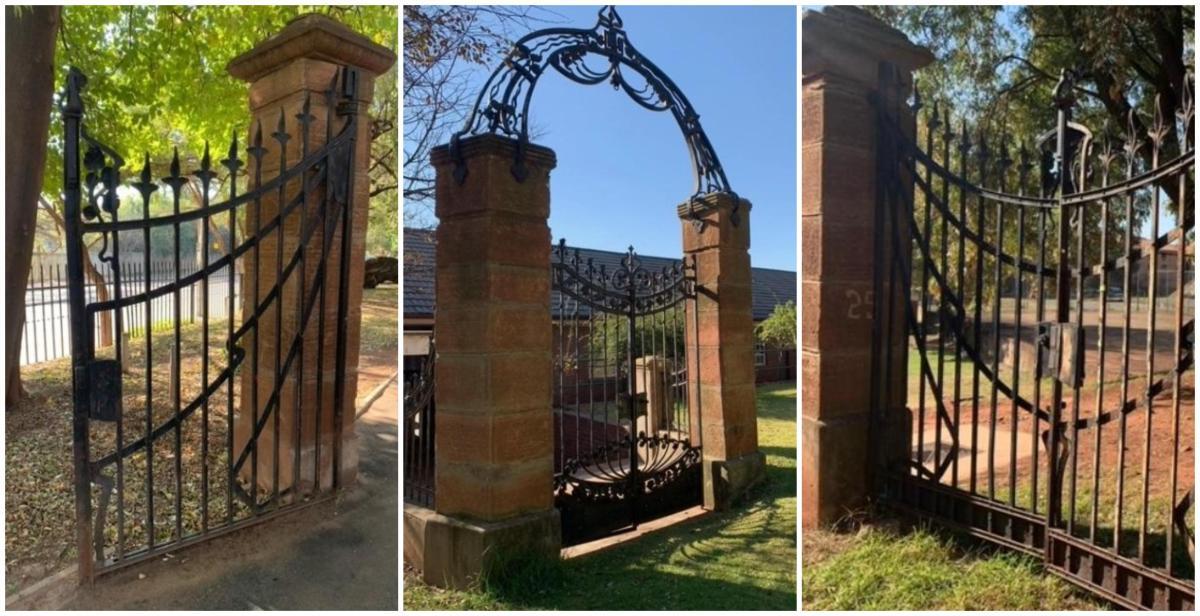
Disclaimer: Any views expressed by individuals and organisations are their own and do not in any way represent the views of The Heritage Portal. If you find any mistakes or historical inaccuracies, please contact the editor.
These impressive gates, a survival from old Parktown, are to be seen at Helpmekaar Girls High or as it is now called, Rand Girls High School, at corner of Empire Road and Melle Street Parktown. The gates were once the pride of the Parktown house Friedaura, one of the original grand Parktown mansions but sadly demolished in the late 1960s. The gates are all that remains.
The mansion was an extraordinary confection; the style was Art Nouveau. The architecture brought the latest fashionable European turn of the century style to Johannesburg, the young town on the Highveld. The architects, clearly entranced by the curvilinear flourishes in flowers and tendrils, were Hermann Kallenbach and his partner of the time, Arthur Reynolds. The date was circa 1903/04 (the date on the porte cochère was 1904).
East Elevation of Friedaura
The suburb of Parktown was established in the 1890s by the Braamfontein Company, an offshoot of the H Eckstein group of companies (familiarly known as Corner House). The style of architecture was fluid and eclectic – with an emphasis on grand reception rooms, entertainment and garden follies. They were the homes of the men who had made their fortunes in the new gold mining town – in mining or banking, merchandising or the professions. Herbert Baker came to the Transvaal with a brief from Lord Milner to upgrade the standard of taste and design; he largely stuck to the English Arts and Crafts style of the late Victorian period.
Baker’s Northwards built for the Dale Lace family in 1906 still survives, though rebuilt after the 1911 disastrous fire (The Heritage Portal)
North Lodge, a near neighbour of Friedaura, on Victoria Avenue was designed by Herbert Aldwyncle in an elaborate French renaissance revival style. (The Heritage Portal)
Dolobran was designed by Cope Christie, perhaps the finest and best known of his architectural imprint on Johannesburg. (Lucille Davie)
The first owner of Friedaura was Heymann Saenger (1859 –1933). He was described in a South African Whose Who entry in 1909 as a financier. He was an immigrant from Germany and was educated in Germany and South Africa. In 1889 he married Annie Jacobsohn and they had seven children. It was a rambling house that was perfect for a large Edwardian family. We wondered who the Friedaura in the house name was, but to date we do not know the origins of the name. Certainly, Parktown houses of the post South African War period were meant to be statements in stone, mortar, turret and cupola. These were homes for the new rich men of the town sited on a Witwatersrand ridge with fine views to the north. These houses included stables, a cow shed and outbuildings to service the family as well as servants’ accommodation. Interiors often included a grand wide generously spread front wood staircase leading to the upstairs bedrooms and a back far more modest service staircase leading to staff bedrooms which might be in an attic or under the eaves.
Friedaura was a home that lasted for no more than two generations and was demolished in the late 1960s. But even earlier in that decade it had ceased to be a family home fit for purpose and slipped into a new role as the boarding house for Helpmekaar Girls School. This was the back story as to how the grand gates came to be saved and were claimed by the school and removed to the school grounds off Empire Road. So much of Parktown disappeared (though we do have some fine survivals).
Last week I went on a journey to find the gates of Friedaura accompanied by Josh Spencer. Josh lived at Friedaura for a year when it was a commune for young long haired hippie students studying art, music, design and architecture. It was just prior to demolition when the property men on the make saw an opportunity for at least covering the cost of security and essentials whilst waiting for the bulldozers to arrive. Josh remembered it as a large property with an orchard and garden but hot water, bathrooms and toilets were in short supply. He nostalgically recalled a giant mulberry tree struck by lightning and split into four but with branches still sprouting and producing a rich cornucopia of fruit.
Detail of a Friedaura turret (Josh Spencer)
The home made such an impression on him that when Josh built his own house in Cape Town, he incorporated a Friedaura inspired art nouveau window. He reminded me that I should again read Peter Strangeways' The Further Adventures of Jim Slater to catch the mood and memories of life in Parktown in the sixties as the suburb fell to the bulldozers and so many of the mansions of this old elite suburb were demolished, giving way to office park developments, the campus of the College of Education (now the Education Campus of Wits University and the then new Johannesburg hospital complex (the Charlotte Maxeke Johannesburg Academic Hospital) and the Wits Medical School. I reviewed this book on the Heritage Portal (click here to read).
The gates of Friedaura are now decorative follies in the grounds of a school and have lost their meaning. The current staff of the school did not know the story of the gates or why they had come to this school.
There were originally four gates – and the grandest for carriages led to a porte cochère fronting the house. There were pedestrian gates and tradesmen’s gates, with gradations in flamboyance and style (and I imagine cost) to define the purpose and who used which entrance.
The most impressive Friedaura gates (Kathy Munro)
Another set of gates at Friedaura (Kathy Munro)
Friedaura gates positioned on a top lawn near a school building and still showing the address of the house (Kathy Munro)
The visit to the Friedaura gates set me thinking about the purpose of gates in Johannesburg. Today, behind high walls, secured and alarmed, gates give access to properties. Often they are automatically opened by a side motor. Entrances are lit. Gates come in a multiplicity of designs and sizes – but the rule is the bigger the better. Gates define property and ownership. Gates are a portal that extend beyond a door. A gate is rather like a portcullis to the private castle. They are the marker between a public street and a private domain. Gates are points of access but also exclusion. Gates make statements about purpose. Are they for pedestrians, or for cars, or for carriages? Gates usually give access to driveways leading to a house beyond, perhaps the house is even invisible. Gated suburbs have electrically operated booms and barriers. My own gate is itself protected by a Chinese talking camera which tells those approaching (in Chinese) to back away! Such is the technology that I have not figured how to turn off the voice or change the language. I marvel at the fact that Friedaura had four gates, and each served a purpose.
At the Rand Girls school, one of the gates, positioned closest to Empire Road and just visible from that road if you know what to look for, is embedded in tar. A case of poor workmanship on a pathway that embedded the bottom of the gate so it is frozen in an open position. There is no easy close or opening and the gates do not swing on their hinges. It is quickly apparent that the gates have been neglected; there is an accumulation of rust and corrosion; decorative balls on gate posts have been lost; there are no light connections. I am excited to find the gates but sad to see their dislocation and neglect.
I have been trying to work out where the gates could have been made – imported from France or Germany? I doubt locally made though there were iron foundries in the Western Cape but doubt that they would have been up to date to create these glorious art Nouveau style gates.
Josh explained that there were four gates, but we only found three. We met the Vice Headmistress Miss Williams who graciously dropped all to show us around the school. Later we met the Headmistress, Ms Amanda de la Rey. A proposal is currently on the table to donate the gates to Helpmekaar College, the boys school as they have requested the gift and a relocation. The first question Miss Williams asks is would heritage legislation permit such a move. It’s an interesting question since the gates have been displaced from their original location and serve no purpose other than that of a curious folly in the gardens of the girls’ school. I cant see a legislative bar. However, removal and re-erection will involve considerable expense, and the fear is that the gates will be damaged for parts lost. Further discussion is planned.
In the new book Johannesburg Diversity (in preparation), the late Clive Chipkin included two photos that he took of the gates when he was working on the Parktown book with Helen Aron. Josh remembered the gate pillars on either side being topped with large balls and electrical light had been installed and hung from the framing iron work. The delicacy and assured design of the metal work signals top quality craftsmanship. I have been searching through the books I have on European metal work – cast iron etc. Any ideas would be welcomed. By the turn of the 20th century the iron and steel industries in both France and Germany were advanced and the Bessemer process had brought down the price of steel. Pig iron was still produced for case and wrought iron work. Could such huge gates have been shipped all the way from Europe to the Transvaal? Very possible but very expensive too.
In the early days of late Victorian and Edwardian Johannesburg and indeed throughout South Africa, wrought iron balconies, gates, barriers and palisades were a feature of many buildings. Some fine metal work came in the form of streetlights and horse drinking troughs or even urinals and were often ordered from the catalogue of Walter Macfarlane and made at the Saracen foundry near Glasgow.
I know of two other Johannesburg schools with fine gates. In May 2024 the Johannesburg Heritage Foundation awarded two blue plaques to Jeppe Boys High. One of the plaques is for the fine gates marking the entrance to the mansion of Sir Julius Jeppe. Again, sadly the gates are all that remain of that mansion. Those gates were imported from the Macfarlane factory.
Friedenheim Gates (Kathy Munro)
The other gates that I am aware of are the three pairs of gates surviving and in place at Barnato Park School in Berea (Barnato Street, Park Lane and Beatrice Street). There was a fourth gate on Tudhope but only the piers survive. These gates were imported from another English foundry, Gardiner and Son, near Bristol and date from the 1890s when they marked the four entrances to the mansion Barney Barnato built at Barnato Park. He never lived to take up residence and the house later became known as Joel House. It then became a boys school, the Johannesburg High School for Boys, which later became the Johannesburg High School for Girls. The house was demolished in early 1963 but the gates still remain. A remarkable survival.
Barnato Park Gates (The Heritage Portal)
The iron work of the first Corner House was relocated to the mansion Dolobran and today is a glorious feature of the garden, front verandah, framing pathways and orchard. Painted green, the iron work has all the patina of age and, as Dolobran is very much an art nouveau house and was a near neighbour of Friedaura, gives us a much more authentic feel for the period and the possibilities of iron decoration than the stranded neglected gates at Rand Girls school.
The gates need to be saved, restored, loved, history recorded, and a blue plaque awarded. My hope is that they will remain at Rand Girls school.
Kathy Munro is an Honorary Associate Professor in the School of Architecture and Planning at the University of the Witwatersrand. She enjoyed a long career as an academic and in management at Wits University. She trained as an economic historian. She is an enthusiastic book person and has built her own somewhat eclectic book collection over 40 years. Her interests cover Africana, Johannesburg history, history, art history, travel, business and banking histories. She researches and writes on historical architecture and heritage matters. She is a member of the Board of the Johannesburg Heritage Foundation and is a docent at the Wits Arts Museum. She is currently working on a couple of projects on Johannesburg architects and is researching South African architects, war cemeteries and memorials. Kathy is a member of the online book community the Library thing and recommends this cataloging website and worldwide network as a book lover's haven. She is also the Chairperson of HASA.
Comments will load below. If for any reason none appear click here for some troubleshooting tips. If you would like to post a comment and need instructions click here.

